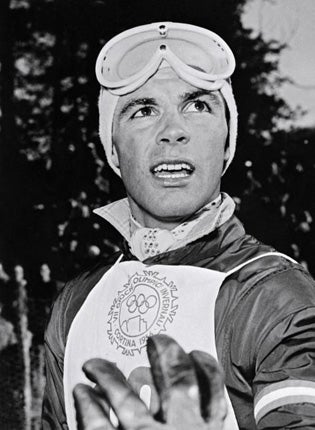Toni Sailer: Olympic skiing champion of grace and power who went on to a career in films and pop music

At the 1956 Winter Olympics in Cortina d’Ampezzo, Toni Sailer, who has died aged 73, not only became the first skier to sweep the Alpine triple crown, winning downhill, slalom and giant slalom, but did it with such domination that his margin of victory in the giant slalom has never been equalled. Sailer’s combination of grace and power was unmatched; rather than shave slalom gates he took a higher line, which meant a longer path but more speed, and demanded more control.
His talent and good looks made him a superstar in Austria, where skiing is the national sport. Sailer (pronounced to rhyme with “miler”) nearly repeated his triple at the 1958 World Championships, taking two golds and a silver in three races.
Then, at the peak of his career, only 23 years old, he retired. He starred in films, made 18 record albums, and returned to coach the national team to world championships in the 1970s. Imagine if, after retiring from football, Bobby Moore had enjoyed Tony Newley’s career, as well as coaching England to a second World Cup title. He would still command only a shadow of Sailer’s status among his countrymen.
Anton Englebert Sailer was born 17 November 1935 in Kitzbühel, home of the legendary Hahnenkamm downhill. Since he often skied in black he was nicknamed “der Schwarze Blitz [black bolt] aus Kitz”. His father owned a glass business, and Sailer trained as a glazier and plumber, but he was skiing almost as soon as he could walk, aged two. At 17 he won his first triple crown, at the Tyrolean championships.
Four years later he destroyed all competition at Cortina, where his 6.2 second margin over his team-mate Andreas Molterer in the giant slalom remains an Olympic best. He took gold in the two-run slalom by four seconds. Then, on an icy downhill that saw eight skiers injured in falls, he broke a bootstrap 15 minutes before the start. Borrowing one from an Italian coach, he won by 3.5 seconds to complete his triple. His feat was matched during the threerace era only by Jean-Claude Killy in 1968. Since the Olympics then doubled as the World Championships, it also meant a fourth World Championship gold as combined champion. At the next World Championship, in 1958 at Bad Gastein, Austria, his countrymen were disappointed when Sailer’s slalom silver prevented his second four-gold sweep.
However, Sailer was soon involved in controversy with the International Ski Federation over his amateur status.
He had been given land in Kitzbühel, on which he built a hotel, and he was already marketing his own brand of ski clothing. He had also, after the 1957 season, begun acting lessons in Berlin, and his first movie, A Piece Of Heaven, was released in 1958. Most damning in the eyes of the FIS, he played a skier, thus profiting from his sporting achievement. Rather than face censure from a sport whose competitions existed primarily to promote resorts and were bankrolled by equipment manufacturers, Sailer retired officially in 1959.
Most of his films were in the old-fashioned “Heimat” genre; romantic melodramas set in lovely mountain scenery, often featuring singing. His second, Der Schwartzer Blitz Aus Kitz (1958), capitalised on his name; he played a skier accused of the high crime, in the Tyrol, of stealing an opponent’s wax. He made 11 films in seven years, including the 1964 Italian sword and sandals epic Samson and the Treasure of the Incas, but only a handful afterwards. He starred in the 1969 TV series Luftsprünge, and played the father in another series in 1993. Sailer enjoyed a parallel career as a schlager, or crooner of thickly sweet ballads, the German word being derived from the whipped cream called schlag, and his line of ski clothing remains hugely popular.
Between 1972 and 1976 he returned as chief trainer of the Austrian national team, helping develop skiers like Franz Klammer and Annemarie Moser-Pröll, who grew up idolising him. He started a hugely successful ski school in Kitzbühel, run by his brother Rudi, but disappeared each summer to his academy on the glaciers at Whistler Mountain, British Columbia.
It was here in 1976 that he married the German golf champion Gaby Rummeny, saying it was the only place they could have privacy. In the mid-1980s he became the race chief for the Hahnenkamm, a role far more than ceremonial given the intense manoeuvring which surrounds the running of any alpine event. It was in this capacity I encountered Sailer, while working for American television on the Hahnenkamm production; his charm and enthusiasm was infectious, making him the ideal ambassador for both the sport and the resort, and allowing him to absorb and deflect much of the ski world’s politicking.
After Gaby’s death in 2000 he returned to the screen in two madefor- television movies and guested in the long-running TV series SOKO Kitzbühel, about mountain police. In 2006 he remarried, to Hedwig Fischer.
He died after a long struggle with a brain tumour and is survived by his second wife and a son, Florian, by his first marriage. Austrian television immediately cancelled their evening programming to show a documentary profile of Sailer and two of his films, including Der Schwartze Blitz.
Michael Carlson
Anton Englebert Sailer, skier, actor, singer, businessman: born Kitzbühel, Austria 17 November 1935; married 1976 Gaby Rummeny (one son), 2006 Hedwig Fischer; died Innsbruck, Austria 24 August 2009.
Subscribe to Independent Premium to bookmark this article
Want to bookmark your favourite articles and stories to read or reference later? Start your Independent Premium subscription today.

Join our commenting forum
Join thought-provoking conversations, follow other Independent readers and see their replies